The United States Air Force (USAF) has a proud tradition that may not date back as far as other military branches yet is significant.
Air Force uniform regulations are one of the many ways that the military branch looks respectful as well as honors its past.
If you are interested in serving in the United States Air Force, then it is important to make yourself aware of uniform regulations, or “regs” for short.
There are four primary types of uniforms that you’ll wear in the Air Force each with its own detailed stipulations.
While it is nearly impossible to memorize all of the Air Force uniform regulations, this article goes over the most important aspects.
Continue reading to learn more about the various USAF uniforms and how to wear them properly:
Related Article – Air Force PT Test Standards
Table of Contents
The 4 Types of Standard Air Force Uniforms
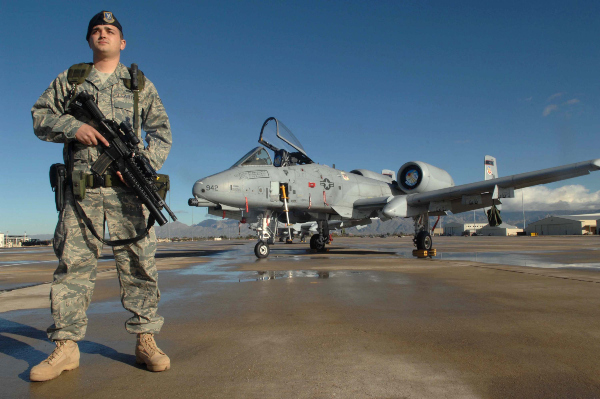
The United States Air Force specializes in air superiority, global integrated intelligence, surveillance and reconnaissance, and global strike capabilities.
It is comparable to other military branches in the U.S. Armed Forces in that airmen are expected to be in uniform at all times when on duty.
Air Force uniform regulations for 2023 designate 4 primary types of attire:
- Service Uniforms
- Formal / Mess Dress Uniforms
- Utility Uniforms
- PT Uniforms
Of course, the uniforms that apply to you primarily depend on your Air Force Specialty Code (AFSC) and your occupational role.
Much may also depend on your rank, as senior service members are often more involved in formal military activities.
The U.S. Air Force refers to its primary utility uniform as an Airman Battle Uniform (ABU).
It is important that you learn the Air Force uniform regulations specific to the ABU, since you’ll spend a lot of time in those clothes.
Furthermore, it doesn’t hurt to learn the basics of the Physical Training (PT) uniform since uniform standards are relaxed yet surprisingly stern in certain aspects of the attire.
You can find everything you need to know about Air Force uniform regulations by consulting the Dress and Personal Appearance of Air Force Personnel handbook.
Basics of Air Force Uniform Regulations
The United States Air Force has strict uniform regulations like the other military branches.
Consequently, airmen are expected to present themselves in the proper attire and with the correct etiquette while representing the U.S. Air Force.
The Air Force uniform standards outline everything you need to know about the 4 standard uniform types along with a protocol for grooming and personal accessories.
It is vital that you present yourself correctly to earn the respect of fellow airmen.
In fact, in the military, there are very few offenses as drastic as failing to wear the proper uniform or ignoring specific details of its layout.
New recruits often have trouble comprehending all the uniform regulations, which is why we recommend you get a head start prior to boot camp.
After all, the official Air Force uniform regulations handbook is over 150 pages, so it’s a stretch to master every reg prior to enlistment.
Nonetheless, this article covers the basics so you won’t get singled out by a commander during basic training for disregarding a common practice.
Presentation is central to military life, which is why such importance is placed on the uniform.
Observing correct uniform guidelines in the military demonstrates excellent self-discipline and personal accountability.
Here are some classic DOs and DONTs in regards to Air Force uniform regulations:
When / Where Can I Wear My Air Force Uniform?
The U.S. Air Force makes it mandatory that all service members be in uniform while performing normal military duties.
As a result, if you are performing any function that is related to the military, you should be in the appropriate uniform.
In general, the Airman Battle Uniform (ABU) is the standard combat uniform, while there is separate attire for physical fitness.
Additionally, specific uniforms or items may be required by installation commanders for regular duties, formations, and ceremonies.
Military personnel that live or operate on a base are in uniform when on duty. Travel is a different story, as airmen may wear or an alternative uniform when traveling in an official capacity.
Airmen also have the choice of donning civilian clothing during official travel on commercial transport. The stipulation is that it is clean, neat, and nothing offensive.
The Department of Defense suggests that recruits consult the Foreign Clearance Guide when venturing to foreign countries.
You’ll learn more about uniform specifics once you are in the Air Force.
For now, remember that for the most part – you are always expected to be in uniform when on duty while serving the USAF with a few exceptions.
Related Article – Best Air Force Bases
When / Where Can I NOT Wear My Uniform?
Since the U.S. Armed Forces are very strict with dress standards, it seems surprising that there are events where you actually shouldn’t wear a uniform.
Airmen should refrain from wearing a uniform when attending a public or private meeting under certain guidelines.
For example, any meeting that is political in nature is a rare time when service members should avoid wearing a uniform.
However, you are unlikely to encounter this situation any time early in your military career.
In general, the Air Force wants you to be in uniform when you are serving the government and not in uniform while in a civilian capacity.
Social occasions, especially those where alcohol is the prime focus, are not an appropriate time to wear your uniform.
The biggest takeaway is to know how to separate military activities from civilian/personal time.
Furthermore, you should never combine military insignia with civilian clothes.
The military branch doesn’t find this professional and it is strictly prohibited.
Regulations For Each Type of Air Force Uniform
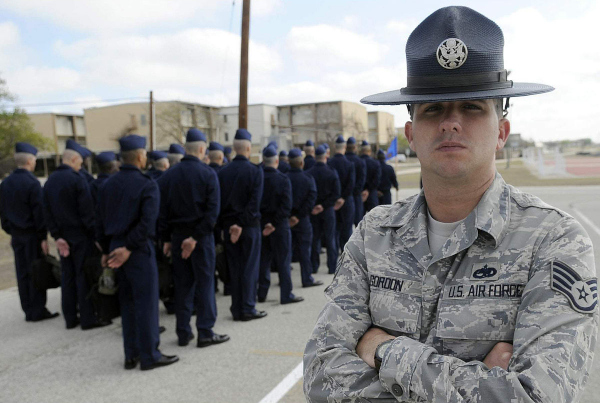
Now that you know the basics of the Air Force uniform regulations (military vs. civilian purpose), it’s time to examine each uniform in detail.
The United States Air Force maintains a philosophy that every uniform in the branch should be “plain, distinctive, and standardized”.
The standardization of the uniform includes a minimum or maximum number of authorized badges, insignia, and devices.
The U.S. Air Force Uniform Regulations manual expresses that it is “most important for all Airmen to maintain a high standard of dress and personal appearance”.
Air Force uniform regulations break down the 5 essential elements of the dress standard include:
- Neatness
- Cleanliness
- Safety
- Uniformity
- Military Image
Every Airman has a responsibility to maintain acceptable uniform standards during their time in the military, including knowing when and where not to wear one.
Moreover, service members are responsible for knowing authorized uniform combinations as well as the correct placement of ribbons, insignia, and badges.
Grooming standards also factor into Air Force uniform regulations, like other military branches.
Additionally, you should make yourself aware of the Air Force tattoo policy which can also violate uniform regs.
These uniform standards exist in the United States Air Force as a way to promote order, uniformity, and discipline.
Consequently, Air Force personnel are expected to be in uniform while performing all military duties.
Combat Uniform (ABU) Regulations
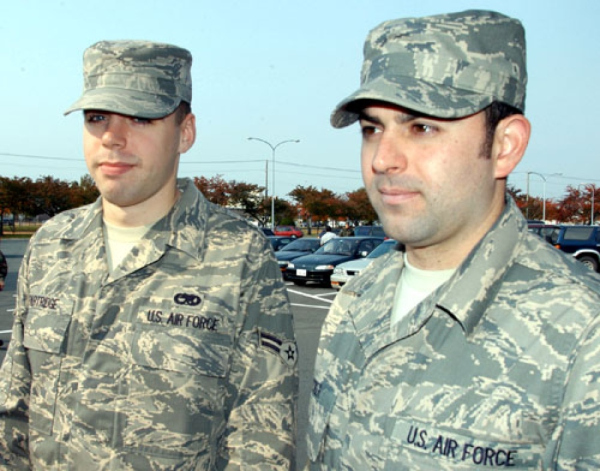
The Airman Battle Uniform (ABU) is the combat uniform of the USAF.
It replaced the Battle Dress Uniform (BDU) as the primary attire for service members while performing military duties.
The Airman Battle Uniform (ABU) consists of the following:
- ABU Coat / Shirt
- T-Shirt
- Hat
- ABU Pants
- Combat Boots
If you have these 5 items of clothing then you have the basic requirements of the Air Force combat uniform.
The United States Air Force allows personnel to wear the ABU off duty only at short convenience stops or while dining at casual or fast food restaurants.
However, the uniform is not considered acceptable to wear at establishments that primarily serve alcohol or more formal restaurants (where other patrons are wearing business attire).
In general, you’ll wear the ABU uniform while on base or carrying out duties of your Air Force Specialty Code.
Airman Battle Uniforms (ABU) Standards
- ABU Coat: The long-sleeved button-up coat should be worn by leaving the top button open (while the remainder of the jacket is buttoned). Some commanders also allow the sleeves to be rolled up.
- ABU Shirt: The Air Force permits short or long-sleeve tees under the ABU Coat. Airmen are allowed to remove the coat in the immediate work area yet must be worn while interacting with others.
- USAF Hat: The hat may consist of an ABU patrol cap, beret, or organizational cap. All 3 are permitted with the uniform and are required outdoors (aside from designated “no hat” areas).
- ABU Pants: The trousers resemble the same material and look of the ABU coat. Personnel have the option of tucking the bottom into the boots. Airmen sport the same desert sand-colored belt.
- Combat Boots: Footwear is incredibly important in the military, especially with the combat uniform. Consequently, sage green boots are traditionally worn though some work areas require alternative black boots. Regardless, make sure the laces are tied and tucked into the boot (or wrapped around).
The head-to-toe expectations get even more complicated when you factor in insignia, badges, and name tapes.
You can find a more detailed resources on these expectations on the official USAF website.
Related Article – Air Force Basic Training Graduation Dates
Service Uniform Regulations
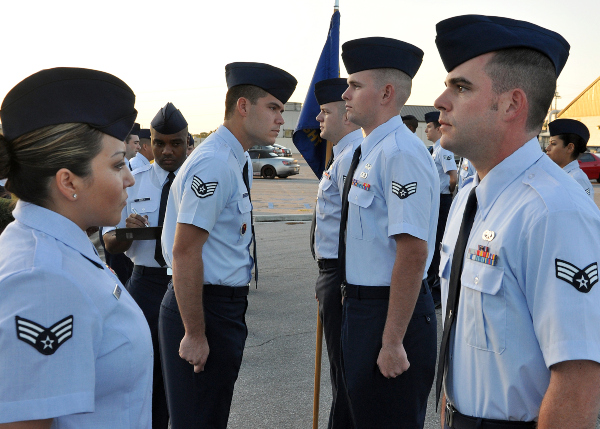
The Air Force service uniform is an alternative everyday uniform that commonly replaces the combat uniform.
It is the military equivalent of business wear for both men and women.
As a result, the clothing items are straightforward and feller regulations exist with the service uniform:
- Long or Short-Sleeve Shirt
- Military Trousers or Slacks
- Combat Boots
The clothing items are basic for the service uniform so it is more important to pay attention to accessories.
The name tag, chevrons, and aeronautical badges are required to get presented with the AF service uniform.
A maximum of 4 earned badges can be worn with all blue service uniforms and aeronautical badges must be worn above all the other honors.
However, it is optional to wear ribbons (miniature or regular-sized).
Air Force Service Dress and Service Uniform Standards
The USAF service uniform falls into two categories: Class As or Class Bs.
Class As, or Service Dress Uniforms, are more formal and require the wear of blue service dress coat for both men and women.
Class Bs, or Service Uniforms, are more casual and comprise a similar combination of blue uniform items without the wear of the dress coat.
Class As are generally worn to more formal military functions, during ceremonies, important presentations, and frequently during official travel.
Class Bs are considered everyday duty wear for most Airmen working at desk or office positions.
The primary difference between the two is whether the suit jacket is worn.
- Jacket / Coat: Comparable to a business suit jacket, the service coat is dark blue
- Long-Sleeve/Short-Sleeve Shirt: Airmen have the option of a long or short-sleeve shirt for the service uniform. The color is light blue to complement the trousers or slacks.
- Air Force Trousers: USAF uniform trousers must match the same material as the jacket, in the same color and fabric. Female Airmen have two options and can wear the approved slacks or uniform skirt.
- Footwear: “Low Quarters,” or Oxford shoes are authorized to wear with the service blue uniform for both men and women. Oxfords are authorized for the blue service dress uniform for men and enlisted women. Dress boots are authorized for both men and women with trousers or slacks. Female Airmen may also wear low-heeled pumps.
If you really want to dig deep, you can find some other important details about the service uniform by referencing this resource.
Nonetheless, you’ll learn most of the uniform procedures at basic training, so mostly focus on the fundamentals of the attire.
The uniform requirements and options become more complicated as you gain experience, so you’ll have plenty of time to learn as you gain rank.
Mess Dress Uniform Regulations
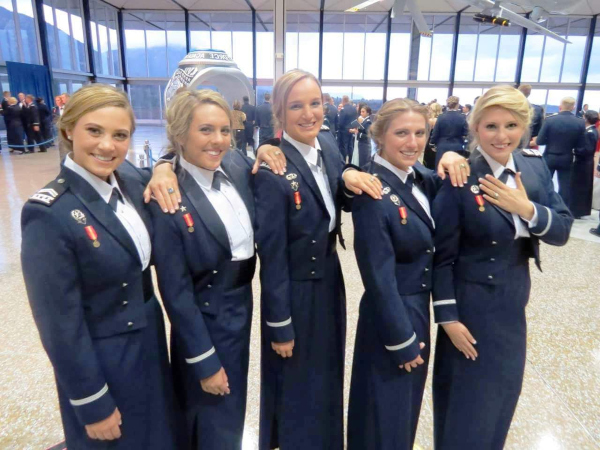
The U.S. Air Force mess dress is the norm at formal military events.
It’s the military equivalent of a tuxedo, which means you will not wear the uniform as frequently, though its presentation is extremely important.
The Air Force mess dress is worn by male and female service members at official formal evening events and state functions.
Mess Dress is required for officers, but optional for enlisted members, who may wear semiformal service dress instead.
The Air Force uniform regulations for the mess dress vary between male and female service members.
Male service members wear a single-breasted coat with satin lapels that falls to right below the waist.
Women’s mess dress includes a similar coat, with comparable styling to the men’s jacket.
Both men and women are required to wear a cumberbund with the mess dress.
Mess dress includes a bow tie for men and a tie tab for women.
USAF mess dress includes high-waist trousers and suspenders for men and a long split formal skirt for women.
Men don white commercial white tuxedo shirts, while women wear the mess dress pleated blouse in white.
Name tags are not worn with mess dress, but medals in miniature are the norm, with no more than two occupational badges.
Meanwhile, the other badges and cuff links are optional with the Air Force mess dress.
Semi-Formal Dress Uniforms
For enlisted members who haven’t yet invested in mess dress, the semi-formal dress uniform is authorized for official social functions.
The enlisted semi-formal uniform consists of the dress blue uniform without the name tag worn with a white shirt, plain blue tie or tie tab, and service dress trousers or skirt (for women).
Air Force Mess Dress Uniform Standards
- Headgear: No headgear is worn with mess dress, except for blue winter cap outdoors with full-length outerwear.
- Blue Mess Dress Coat: The jacket adds to the formal presentation of the service member at the formal event.
- Long-Sleeve Tuxedo Shirt: The shirt is generally white, may be pleated, and is worn under the jacket.
- Trousers or Skirt: Men wear trousers with suspenders and women wear a long formal skirt with a side slit.
- Footwear: Male Airmen wear low-quarter Oxfords with mess dress, while female Airmen wear pumps with formal and semi-formal uniforms.
PT Uniform Regulations
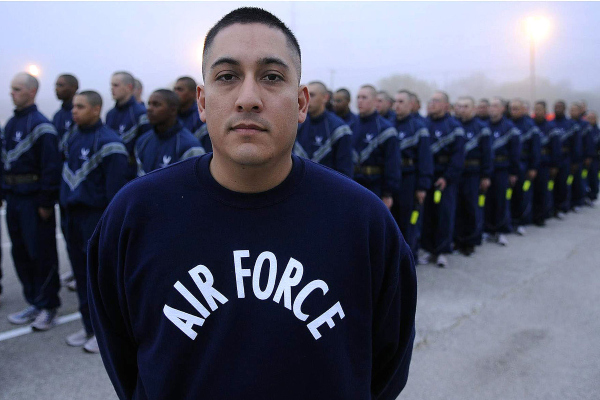
The U.S. Air Force recently developed new PT uniforms. The new uniforms are better at moisture-wicking while also presenting a fresh new style.
Nonetheless, what you need to know about PT uniforms is that they are the most casual attire you’ll wear in the military outside civilian activities.
As the name implies, the Air Force Physical Training Gear (PTG) uniform is reserved for USAF personnel and retirees during fitness training.
Thus, the concept is not too sophisticated as the old PT uniforms consisted of a blue t-shirt and gray pants or shorts.
The upgraded design of Air Force PTG uniforms is intended to make them more comfortable during intense exercise.
As a result, Air Force uniform regulations for PT are much more relaxed so long as you have the correct shirt, pants/shorts, and footwear.
Furthermore, airmen are allowed to alter the PT uniform to accommodate the weather (hot day vs. cold day).
There is no need to worry about wearing Air Force insignia or medals as this would be counterproductive to a workout.
The wear of PTG is mandatory during any physical fitness assessment or during organized PT events.
You’ll be able to wear your PTG whenever you’re exercising alone, as long as you stick to a few guidelines.
Air Force PT Uniform Standards
- PTG Jacket: The jacket must be zipped at least halfway between the waist and collar.
- PTG T-Shirt: You can leave your PT tee untucked as long as it doesn’t cover the reflective material on your shorts. PTG shirts are white, black, or light gray.
- Pants or Shorts: Blue pants are generally worn for colder weather while shorts are allowed in warmer temperatures.
- Footwear: Athletic sneakers are mandatory, worn with solid-colored socks of black, white, dark blue, gray, or desert sand. They may also have a small brand logo.
Related Article – Air Force Signing, Enlistment, and Reenlistment Bonuses
Conclusion
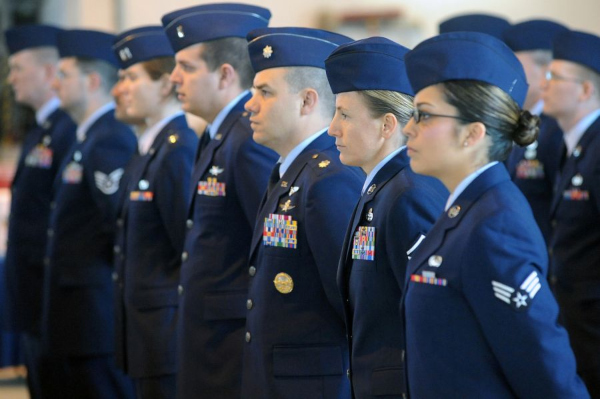
Air Force uniform regulations are established for a reason.
Every military branch in the U.S. Armed Forces follows strict guidelines for military clothing and presentation.
The purpose of having uniform standards is to demonstrate to the public that the military branch is organized and disciplined.
Consequently, it is important that you learn about Air Force uniform regulations before basic training.
While you do not need to memorize every rule in the handbook, knowing the basics will prevent you from getting into trouble during boot camp.
For this reason, knowing what Air Force uniform is appropriate for the situation (as well as specific requirements of the attire) reflects well to superiors.
Furthermore, Air Force grooming standards and its tattoo policy also play into the uniform regulations, so make sure you study those obligations too.
See Also
- Ikon Pass Military Discount: Learn How To Save Big - January 31, 2025
- RTIC Military Discount: Find Out How To Save Big on Gear - January 30, 2025
- Traeger Military Discount: Learn How To Save Big on Smokers - January 28, 2025

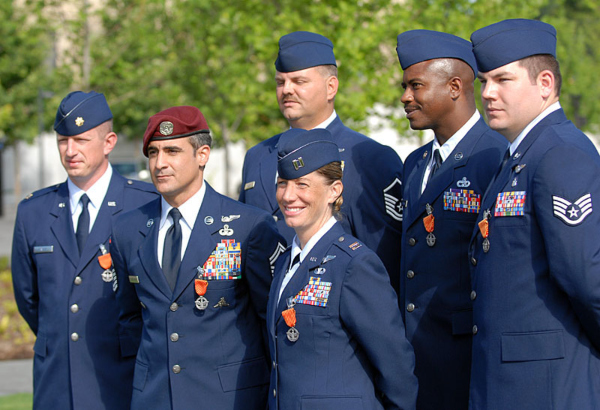

Rob, sorry to be a nit-picker, but a certain misspelling is occurring consistently within this article. It is a distraction from the content when encountered. The word “don and donning” are the correct words when speaking of putting on a garment. It’s opposite is “doffing.” One dons and doffs their hat for example. It is not “dawn.” Offered in constructive spirit to keep your article enjoyable. Thank you
You’re right, I must have missed it during the review process. Just made the changes, and will check other articles for this error. Thanks for the constructive criticism, Vicki!
Rob V.
OMK Founder